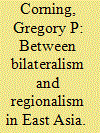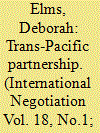|
|
|
Sort Order |
|
|
|
Items / Page
|
|
|
|
|
|
|
| Srl | Item |
| 1 |
ID:
092137


|
|
|
|
|
| Publication |
2009.
|
| Summary/Abstract |
This paper examines economic regionalism in East Asia with a focus on the key issues in harmonizing bilateral free trade agreements. The ASEAN+1 free trade agreements with China, South Korea and Japan represent the first attempts to structure cooperation in trade across Southeast and Northeast Asia. It is therefore important to examine the coverage of these agreements and the extent to which they actually liberalize trade. This study focuses on major choices made in the negotiation of the ASEAN-Japan Comprehensive Economic Partnership Agreement and the ways in which these choices help or hinder the consolidation of economic regionalism. The results achieved in the ASEAN-Japan Comprehensive Economic Partnership Agreement are limited at best. The agreement does establish some new areas of cooperation among the signatories but fails to address important issues for regionalism such as labor mobility. It also makes limited progress in harmonizing and liberalizing rules of origin. The ASEAN-Japan Comprehensive Economic Partnership Agreement applies product-specific rules to fewer categories of goods than most of Japan's bilateral agreements with ASEAN members but those rules in place are still very restrictive. Moreover, the parties to the ASEAN-Japan Comprehensive Economic Partnership Agreement have the option of applying the rules of their bilateral agreement if it provides more favorable treatment. Thus, there is no guarantee the more liberal terms of the ASEAN-Japan Comprehensive Economic Partnership Agreement will be applied.
|
|
|
|
|
|
|
|
|
|
|
|
|
|
|
|
| 2 |
ID:
086135


|
|
|
|
|
| Publication |
2009.
|
| Summary/Abstract |
The recent proliferation of regional trade agreements in the East Asian region can be seen as the most notable development in the region's trading panorama in recent years. Yet, very little is as yet understood about the anatomy of these agreements and, consequently, their full implications to the regional economy. This article strives to fill this gap by analyzing the structure of four dozen RTAs by their various key component parts, including tariff liberalization schedules, rules of origin, and competition policy, customs, investment, and services provisions. The results reveal that intra-Asian RTAs are generally quite rapidly liberalizing, with the exception of agriculture, but they are also quite thin in trade-related disciplines when compared with the more legalistic US trans-Pacific RTAs and those of Mexico and Chile. The proposed Free Trade Area of the Asia-Pacific would inherently be a construct of the political economy interests of these various constituent RTAs.
|
|
|
|
|
|
|
|
|
|
|
|
|
|
|
|
| 3 |
ID:
120716


|
|
|
|
|
| Publication |
2013.
|
| Summary/Abstract |
Abstract Much has been made of the "spaghetti or noodle bowl" problem of overlapping preferential trade agreements (PTA). A new PTA, the Trans-Pacific Partnership (TPP), currently under negotiation between eleven states - Australia, Brunei, Canada, Chile, Malaysia, Mexico, New Zealand, Peru, Singapore, the United States and Vietnam - is intended to help address this issue. The TPP will lower or eliminate barriers to trade among the partners. But officials are not operating in a vacuum as they negotiate this new agreement. Instead, they must contend with rules created in previous agreements, many of which link TPP partners together in ways that constrain their options now. This article looks in detail at negotiations over market access in goods to better understand the tradeoffs faced by negotiators. Unfortunately, some of the decisions made so far after three years of talks suggest that the TPP market access deal could end up being just another twisted noodle in a crowded bowl.
|
|
|
|
|
|
|
|
|
|
|
|
|
|
|
|
|
|
|
|
|